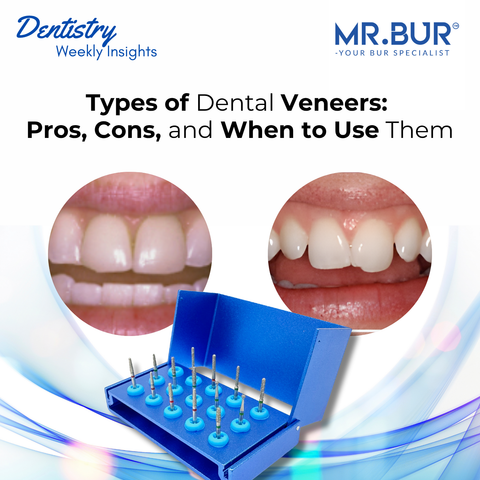In modern restorative dentistry, precision is paramount, not only in diagnosis and material selection, but also in cavity preparation. Among the tools that significantly influence clinical outcomes, the choice of rotary instrumentation is critical. Diamond burs have emerged as essential instruments, especially when smooth margins, conservative enamel removal, and minimal vibration are desired.
This article explores optimal diamond bur selection and technique for each of G.V. Black’s Class I to VI cavity preparations, incorporating procedural guidance and Mr. Bur’s system, a practical framework that standardizes bur usage by shape, grit, and application.
G.V. Black’s Classification: A Functional Overview
G.V. Black’s classification system categorizes cavity types based on the surfaces involved. Though developed over a century ago, it remains foundational in operative dentistry, especially for guiding prep design and access.
|
Class |
Location |
Description |
|
Class I |
Pits and fissures |
Occlusal surfaces of molars/premolars; lingual surfaces of anterior teeth |
|
Class II |
Proximal surfaces of posterior teeth |
Involves mesial or distal surfaces of premolars and molars |
|
Class III |
Proximal surfaces of anterior teeth |
Excludes the incisal edge |
|
Class IV |
Proximal surfaces of anterior teeth |
Includes the incisal edge |
|
Class V |
Cervical third of facial or lingual surfaces |
Involves the gingival margin |
|
Class VI |
Incisal edge or cusp tip |
Often due to wear or trauma |
Class I – Pit and Fissure Lesions
Surface Involved
-
Occlusal pits and fissures of molars and premolars
-
Buccal and lingual pits of molars
-
Lingual pits of maxillary lateral incisors
Bur Selection
-
Round Ball Coarse Diamond Bur FG – For initial caries access
-
Taper Flat End Coarse Diamond Bur FG – For shaping and smoothing the internal walls
Technique and Clinical Considerations
Begin with a coarse-grit round diamond bur to access the pit or fissure conservatively. Penetrate only as deeply as necessary to remove decay or reach the dentino-enamel junction. Extend the outline form only into fissures showing signs of demineralization or decay. Avoid overextending into clean anatomy to preserve occlusal structure.
Switch to a flat-end tapered bur to refine the internal form. The goal is to create slightly divergent walls (from pulpal to occlusal) to aid in retention without producing undercuts. Smooth the cavosurface margin to reduce stress points and facilitate marginal seal of the restorative material. Always maintain water spray to prevent overheating and control dust.
Class II – Proximal Lesions of Posterior Teeth
Surface Involved
-
Mesial or distal surfaces of premolars and molars
Bur Selection
-
Taper Round End Coarse Chamfer Diamond Bur FG – For occlusal drop and box entry
-
Taper Flat End Coarse Diamond Bur FG – For gingival seat and axial wall formation
-
Fine Grit Pre-Polishing Flame Diamond Bur FG – For interproximal wall smoothing and margin finishing
Technique and Clinical Considerations
Start by establishing access through the occlusal surface using a taper round diamond bur. Drop into the proximal box carefully, ensuring that the bur remains perpendicular to the occlusal plane to avoid gouging the adjacent tooth. Establish clear mesial or distal access while maintaining a conservative isthmus width.
Use the Taper flat end bur to shape the box and define the gingival floor. Aim for a flat, horizontal gingival seat, with facial and lingual walls that gently converge occlusally. Maintain a smooth, clean axial wall, ensuring it is slightly convex toward the pulp to follow the contour of the tooth.
Use a fine-grit flame bur to finish the proximal box margins and smooth the cavosurface angles. Proper polishing reduces the risk of microleakage and improves composite adaptation. Avoid sharp internal line angles to minimize stress concentration.
Class III – Proximal Lesions in Anterior Teeth (No Incisal Edge Involvement)
Surface Involved
-
Mesial or distal surfaces of incisors or canines
Bur Selection
-
Fine Grit Pre-Polishing Super Needle Diamond Bur FG – For lingual access to the lesion
-
Fine Grit Pre-Polishing Flame Diamond Bur FG – For smoothing axial walls and facial margins
Technique and Clinical Considerations
Access is best gained from the lingual surface to preserve labial enamel, particularly for esthetic reasons. Use a fine needle-shaped bur to create a conservative entry point, avoiding overcutting. Carefully extend toward the proximal lesion while checking clearance with the adjacent tooth.
Once inside the lesion, refine the internal walls using a flame-shaped diamond bur. Pay particular attention to smoothing the axial wall and feathering the margins for optimal composite adaptation. Enamel margins should be beveled lightly, especially if bonding is planned, to increase surface area and improve long-term esthetic blending.
Isolation with a rubber dam and magnification are highly recommended for anterior proximals, where visibility and control are critical.
Class IV – Anterior Lesions Including the Incisal Edge
Surface Involved
-
Proximal and incisal areas of anterior teeth, often following trauma or deep decay
Bur Selection
-
Taper Flat End Coarse Diamond Bur FG – For incisal reduction and establishing the outline form
-
Straight Torpedo Diamond Bur FG – For beveling interproximal and lingual margins
-
Fine Grit Pre-Polishing Flame Diamond Bur FG – For precision beveling on the facial surface and smoothing contour transitions
Technique and Clinical Considerations
Start by using the taper flat-end bur to remove unsupported incisal enamel and define the external outline of the preparation. This is especially important when managing fractured or structurally compromised anterior teeth.
Next, use the straight torpedo bur to create bevels on the interproximal and lingual margins. These bevels enhance bonding surface area and facilitate seamless transitions between composite and enamel, reducing visible margin lines.
For facial beveling and precise margin control, introduce the flame-shaped bur. Its elongated shape allows for controlled enamel beveling along broad facial surfaces without excessive removal.
Class V – Cervical Third Lesions
Surface Involved
-
Facial or lingual surfaces near the gingival margin, often from abrasion, erosion, or root caries
Bur Selection
-
Inverted Cone Coarse Diamond Bur FG – For outline form and caries removal
-
Fine Grit Pre-Polishing Egg Diamond Bur FG – For adapting to the convex cervical curvature
-
Super Fine Finishing Flame Diamond Bur FG – For gingival margin smoothing
Technique and Clinical Considerations
Use an inverted cone to outline the lesion conservatively and remove any demineralized enamel or dentin. Avoid creating sharp internal angles, particularly near the cementoenamel junction, where structural weakness can develop.
An egg-shaped bur helps maintain the natural curvature of the cervical third, preventing flat, unnatural contours. Smooth margins ensure better seal and adaptation of the restorative material.
Pay special attention to gingival margins. Avoid damaging soft tissues and maintain a clear finish line just above or at the gingival crest. Irrigation and a steady handpiece are essential to prevent overheating of thin dentin or exposed root surfaces.
Class VI – Lesions on Incisal Edges or Cusp Tips
Surface Involved
-
Incisal edges of anterior teeth or functional cusp tips of premolars and molars
Bur Selection
-
Round Ball Coarse Diamond Bur FG – For accessing and outlining the lesion
-
Taper Flat End Coarse Diamond Bur FG – For contouring the functional surface
-
Super Fine Finishing Flame Diamond Bur FG – For final polish and finishing
Technique and Clinical Considerations
Lesions in these areas typically arise from attrition or parafunctional habits. Begin by outlining the affected area with a round diamond bur, removing any unsupported or worn enamel. Use light pressure to avoid excessive removal of sound structure.
Shape the functional area, whether cusp or incisal edge, with a tapered-flat end bur, maintaining original tooth anatomy for proper occlusion. Evaluate centric contacts and functional movements to ensure that the final restoration will not interfere with occlusal dynamics.
Finish with a super fine finishing flame bur to smooth and polish all surfaces, reducing the risk of microcracks and improving esthetics. Given the high-stress nature of these areas, material selection and smooth transitions are essential to avoid fracture.
The Value of Bur Precision
Diamond burs are more than cutting tools, they are instruments of control and finesse. Using the correct bur for each GV Black class ensures not only proper form and function but also facilitates adhesion, improves restoration longevity, and enhances esthetic outcomes.
Mr. Bur offers a structured, efficient approach to bur selection, particularly beneficial in teaching environments and clinical practice where predictability and consistency are essential. By aligning bur design and grit with each cavity type, clinicians can reduce variability and improve procedural quality.
In New Zealand, dentists strive to provide exceptional care supported by dependable clinical tools. From Auckland to Christchurch, practitioners rely on well-crafted instruments that deliver accuracy and performance. Explore dental products tailored to meet the expectations of New Zealand’s dental community.
Diamond Burs, Carbide Burs, Interproximal Reduction Bur Kit, Surgical & Lab Use Burs, Endodontic burs, Crown Cutting Kit, Gingivectomy Kit, Root Planning Kit, Orthodontic Kit, Cosmetic Restorative 3-in-1 Kit FG, Surgical Crown Lengthening Kit FG, Composite Polishers, High Speed Burs, Low Speed Burs









